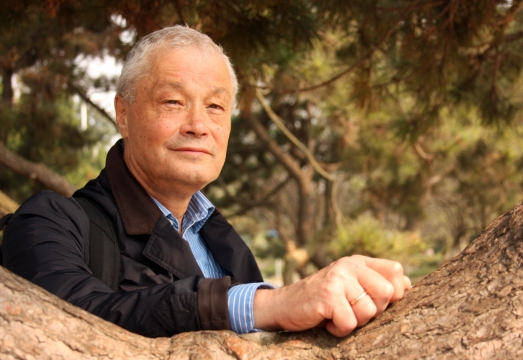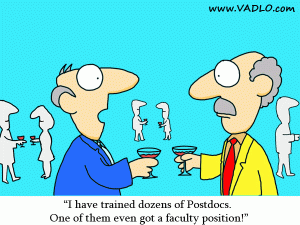A few months ago my (first) academic job search epic came to an end. In January 2016 I will start the Kryazhimskiy Lab at UCSD, in the Section of Ecology, Behavior and Evolution. I thought it might be useful for the next generation of applicants to summarize my experience. So, here we go.
Some stats
Let’s start with data.
|
2013 |
2014 |
| Applications |
20 |
29 |
| Interviews |
1 |
11 (+1) |
| Offers |
0 |
3 (+1) |
I applied for jobs two seasons in a row. I started applying in the fall of 2013 and continued throughout the fall of 2014 (I also sent out a very small number of applications in 2011, but I was clearly not ready then). My applications in the two seasons were essentially identical: same CV, same recommendation letters, same ideas in the research statement. For complete disclosure, I did rewrite my research statement in 2014 and I do think it became better. The main difference though between applications was a single line in my publication list. In June 2014 our Science paper came out. Importantly, by the time of my 2013 application, all experiments were finished and data were largely analyzed and described in my research statement. In other words, my case is a nice test of the effect of a single Science paper on academic job search performance.
The effect is striking. In 2013 I sent out 20 applications and got 1 interview. It is at that time that I wrote this depressing post. In 2014 I sent out 29 applications and got 12 interviews, one of which I declined. In fact, there were 4 departments to which I applied both in 2013 and 2014, and I got an interview at 2 of them in 2014 but none in 2013. As a result, I got 3 offers in 2014. One additional university was prepared to give an offer, but came through too late in the game. From what I hear from other colleagues who recently applied for jobs in biology, an overall 10% success rate is pretty reasonable.
What do we learn from here? I think two lessons.
First, it appears to be very important to have a major paper from your postdoc published. Not in preparation, not on bioRxiv, not in review. Published. Preferably in Cell, Science, or Nature. I guess we all know that by now.
Second, even if you have a major paper out, you should send 10+ applications to ensure a decent chance of success.
There are certainly exceptions to these “rules”. I think there are essentially two “tracks” for getting a job. On the slow track (which is what I did) you do a regular postdoc (or multiple), where you obtain a solid if not stellar publication record and get your name recognized in the field. To start on the fast track, you have to have a stellar PhD (i.e., one or more high-profile papers). To continue, you need to get a prestigious independent postdoc position, e.g., Harvard society fellowship, Miller fellowship, etc. Then you might be able to get a tenure-track job after just one or two years of this super-postdoc even without major publications.
Time investment
One important thing to consider in applying for jobs is time investment. Putting together an application takes a lot of time. I spent 2 to 3 weeks working full time on my research statement in 2013 and another 2 weeks in 2014. Plus one week on teaching statement. Plus 3-4 days crafting an effective cover letter. You may be able to do better than that if you are a fast writer, but even then conceptualizing your research program, coming up with specific projects, and going through two or three feedback/re-writing iterations still takes time. Adjusting your statement to different page restrictions is another time-sink factor. Finally, you might want to tailor your statement to different types of departments. For example, I applied to ecology and evolution departments and to systems biology departments. Even though all core ideas and proposed work of course remained the same, I did frame them in different ways.
Once I had a couple of versions of the research and teaching statements and the cover letter backbone, it took me about 1 day per application. I looked up the department and carefully re-read the job ad trying to understand what kind of person they might want. So, I tried to place appropriate accents in the cover letter and to a lesser extent in the research statement to make my application slightly more appealing to a particular department. I have no idea whether it played any role or not. According to this post, it might. If I read my application, I would probably conclude that the person took the application process seriously.
Given this considerable time investment, the major question is: is it worth it? If you have a good chance of getting a job the answer is obviously “yes”. The answer is not necessarily “no” even if think that your chances are not great. There are three reasons for that. First, you never know your chances until you try. Second, if you get even just one interview, it is a very valuable practice for the future. Third, even if you do not get any interviews, going through the process of writing the research statement is not a complete waste of time. Conceptualizing your research program takes a lot of time, and I truly believe it is helpful to start writing early. My current research statement is compelling, but the one I wrote back in 2011 is much less so. And I arrived at my current level of conceptualization through multiple iterations which were spaced out by several months and interspersed with reading and digesting new papers and talking with smart people. In short, writing your research statement is a fairly useful time investment. However, it has to be weighed against the time investment into actual research and paper production. And the equation is simple. If you have awesome papers, you will likely get by with a poor research statement (I know of such precedents). If you don’t have papers, a fantastic research statement will never get you even an interview.
A couple of notes on how I wrote my research statement
There are probably good guides for writing research statements out there, but here are my five distilled ingredients.
- Vision. In my mind, vision encompasses a deep scientific problem and a series of approaches to attack it. This is the glue that holds the whole statement together.
- Focus. I tried to structure my statement so that it feels like every proposed project fits with the vision rather than goes off in a different direction. The reader should feel that if you accomplish all these projects, the field will advance in a major way.
- Clarity. Keep in mind that the first reading will unlikely take more than 10–15 minutes. So, better to assume too little knowledge on part of the reader than too much.
- Expertise. I tried to demonstrate that I have enough expertise to accomplish each proposed project. In parts where my expertise was clearly lacking, I explicitly mentioned relevant collaborators at the particular institution.
- Scope. I was given the following advice. There have to be enough ideas in the proposal to fuel a lab for five-seven years. Estimate how much work each project will take. There should be more work than you can accomplish yourself, but not so much that it will require a whole institute.
On the importance of networking
Everybody says that networking is very important, but it is actually pretty hard to pinpoint how it actually plays in. Here is my data.
| Departments |
Got interview |
Did not get
interview |
| With direct connection |
7 |
7 |
| Without direct connection |
5 |
10 |
I am showing here the numbers of departments to which I applied in 2014 stratified by the presence of at least one faculty member who knew me personally (“with direct connection”; NB: I have no information on whether this person was on the committee or not) versus no such faculty members (“without direct connections”). So, it looks like the chances of getting an interview at a department with a direct social connection are a bit better (50% vs 33%). Still, publishing (at least in high-profile journals) is a much better way to improve chances of success than networking.
Interviews
My interviews began in November and finished in March. There are a couple of interesting things that I learned, both about myself and about the process.
First, the delivery of my talk varied a lot, and the only predictor that I could come up with is whether there were people in the audience who intimidated me on a purely subconscious level. The presence of such people sometimes caused me to fluster. I noticed that this behavior was aggravated by lack of sleep suppressed with coffee. The lesson is: Your body and mind can behave in unusual (annoying) ways under stress, lack of sleep, and various kinds of intoxication. These undesired behaviors can be controlled, but it is important to pay attention and not to aggravate them.
Second, the variation in the quality of the departments is staggering. I applied only to places where I could potentially see myself work and my family live. Even so, the departments where I interviewed varied from absolutely stellar (which is what I got used to during my PhD and postdoc years) to I-would-rather-quit-science-than-go-there kind of places. It’s good to keep in mind that before a physical visit you have no idea of what the department is like. Some places that you think are not even worthwhile applying to may turn out to be really great, and vice versa.
Third, my ability to predict after the interview whether I would get an offer was close to zero. The only exception were failed interviews, i.e., if I thought the interview went bad, it most certainly did. The converse was not true at all: interviews that I thought I nailed did not necessarily result in offers. After each interview, just for fun I wrote down my perceived probability of an offer (either 10%, 25%, 50%, 75%, or 90%). The average value of this probability for places that did indeed offer was 63% (±20%); and for places that did not offer it was 44% (±15%). So, barely better than coin tossing.
After the offer
I was lucky enough to receive the first verbal offer after my second interview in early December. You might think that this alleviated much of the stress of subsequent interviews, but it actually did not because the offer was from the place that was not number 1 in my internal preference list (which was misguided, see above). Moreover, when most of the interviews started, the soothing effect of the offer wore off. By January it seemed more like a distant dream than reality, and since it was a verbal offer I had no document to convince me otherwise.
In any case, in the first week of March I received two more verbal offers. After that the negotiation process began. There are several important things that I learned in this process. First, until you have a written letter in your hands, nothing is certain. I have heard of multiple cases when the unofficial offer was withdrawn. So, work towards obtaining a written letter from the first phone conversation.
Second, as in any negotiation process, it’s very important to know what you want. You have to have a very clear hierarchy of priorities. And I think it is best to put out all the “deal breakers” right out on the table. This way, it will be no surprise and hopefully no bad blood if you fail to come to an agreement.
Third (and this is an advice from a senior colleague), if you have multiple offers, you have one “trump card”. You can say “If you make X happen, I will come here”. It is likely that X will happen if it is at all in Chair’s power. Obviously, you can only say this to different places with which you negotiate sequentially.
Fourth, the success of your negotiations depends heavily on your Chair. It’s Chair’s job to convince the School (the entity that has the money) to satisfy your needs and to do other things that go beyond the University (e.g., contacting potential employees for your spouse). If the Chair is doing a great job, you will receive positive enthusiastic responses to your requests. The enthusiasm of responses is probably the best predictor of how the school and the department will treat you if you actually join. If you have to beg for every single thing (lab space, startup amount, equipment, job for spouse, housing, etc), chances are that you will have to swim against the current during your whole appointment, and you won’t get tenure without competing offers. At that point you will probably ask yourself: would I really want to be in such a place?
That’s almost all I wanted to say about my own experience. Good luck to all of those who are embarking on this miserable journey this year!
NB: I was asked a couple of specific questions which I did not answer above. Here are my answers
- Where did you find job ads?
I used alerts on Nature Jobs and Science Careers, I was subscribed to EvolDir, I occasionally looked through postings on AcademicJobsOnline and Vitae. In my experience, most job ads are posted in multiple venues, so missing a relevant ad (at least for US-based jobs) is almost impossible. I also was incessantly looking (and contributing) to the Ecology Wiki, which I highly recommend for maintaining sanity.
- What would you do differently?
If I knew my chances, I would not have applied in 2013. This would have saved some of my nerves and a lot of my time.
- How important is teaching experience?
Not at all, at least at places where I applied (R1). But you should still put some time in writing a good teaching statement.
- Is outreach important?
No, unless they specifically ask for it.
UPD (27 Aug 2015)
5. What did you do after the interview? Did you follow up or just wait for an offer?
All places where I got offers contacted me themselves. When I got the offers I informed the search committee chairs of places that have not decided yet and that I would seriously consider if they did offer.
6. What were the red-flags that led you to identify “I-would-rather-quit-science-than-go-there kind of places”?
The following questions might help.
1) Do you sense or know of any inter-departmental conflicts? 2) Are theres some awesome people, or does the place feel “stale”? 3) Are there any people who you could collaborate with (or at least talk to about your science) or will you be completely isolated? 4) Are faculty excited about their grad students?





